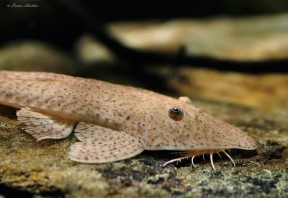Pseudohemiodon laticeps
Giant Whiptail Catfish
SynonymsTop ↑
Loricaria laticeps Regan, 1904
Etymology
Pseudohemiodon: from the Greek ψευδής (pseudes), meaning ‘false’, ἡμι- (hemi-), meaning ‘half’, and ὀδούς (odous), meaning ‘tooth’.
laticeps: from the Latin latus, meaning ‘wide’, and -ceps, meaning ‘headed’.
Classification
Order: Siluriformes Family: Loricariidae
Distribution
Distributed throughout the rios Uruguay, Paraná and Paraguay with records existing from southern Brazil, Paraguay and Argentina.
Type locality is given simply as ‘Paraguay’.
Habitat
Inhabits areas of soft substrate within which it remains buried during the day, emerging to feed at night.
Maximum Standard Length
250 – 300 mm.
Aquarium SizeTop ↑
An aquarium with base dimensions of at least 180 ∗ 60 cm or equivalent is required.
Maintenance
The most important provisions are very clean, stable water conditions and a sandy substrate in order that the fish can exhibit natural behaviour.
Water Conditions
Temperature: 18 – 24 °C
pH: 6.0 – 7.5
Hardness: 36 – 215 ppm
Diet
Likely to be an opportunistic omnivore by nature.
In captivity some sinking dried foods may be accepted but regular meals of live or frozen Daphnia, mosquito larvae, chironomid larvae (bloodworm), etc., are essential for the maintenance of good health.
Reproduction
A paternal ‘lip brooder’ which has been bred in aquaria.
Post-spawning the male carries the eggs attached to his labial barbels for a period of 12-14 days after which the fry hatch with a large yolk sac attached, this being absorbed over the next 48 hours or so.
During incubation the behaviour of the male is apparently unaffected and he may burrow into the substrate with the eggs attached.
Successful captive breeding has tended to involve removing the eggs to a separate aquarium just prior to hatching.
The fry are able to accept Artemia nauplii and suchlike as soon as the yolk sac has been fully-absorbed with a yield of 15-20 considered a good number.
References
- Regan, C. T., 1904 - Transactions of the Zoological Society of London 17 (pt 3, no. 1): 191-350
A monograph of the fishes of the family Loricariidae. - Evers, H-G. and I. Seidel, 2005 - Mergus Verlag GmbH, Melle: 1-943
Catfish Atlas: Volume 1 - Ferraris, C. J., Jr., 2007 - Zootaxa 1418: 1-628
Checklist of catfishes, recent and fossil (Osteichthyes: Siluriformes), and catalogue of siluriform primary types. - Reis, R. E., S. O. Kullander and C. J. Ferraris, Jr. (eds) , 2003 - EDIPUCRS, Porto Alegre: i-xi + 1-729
Check list of the freshwater fishes of South and Central America. CLOFFSCA.



